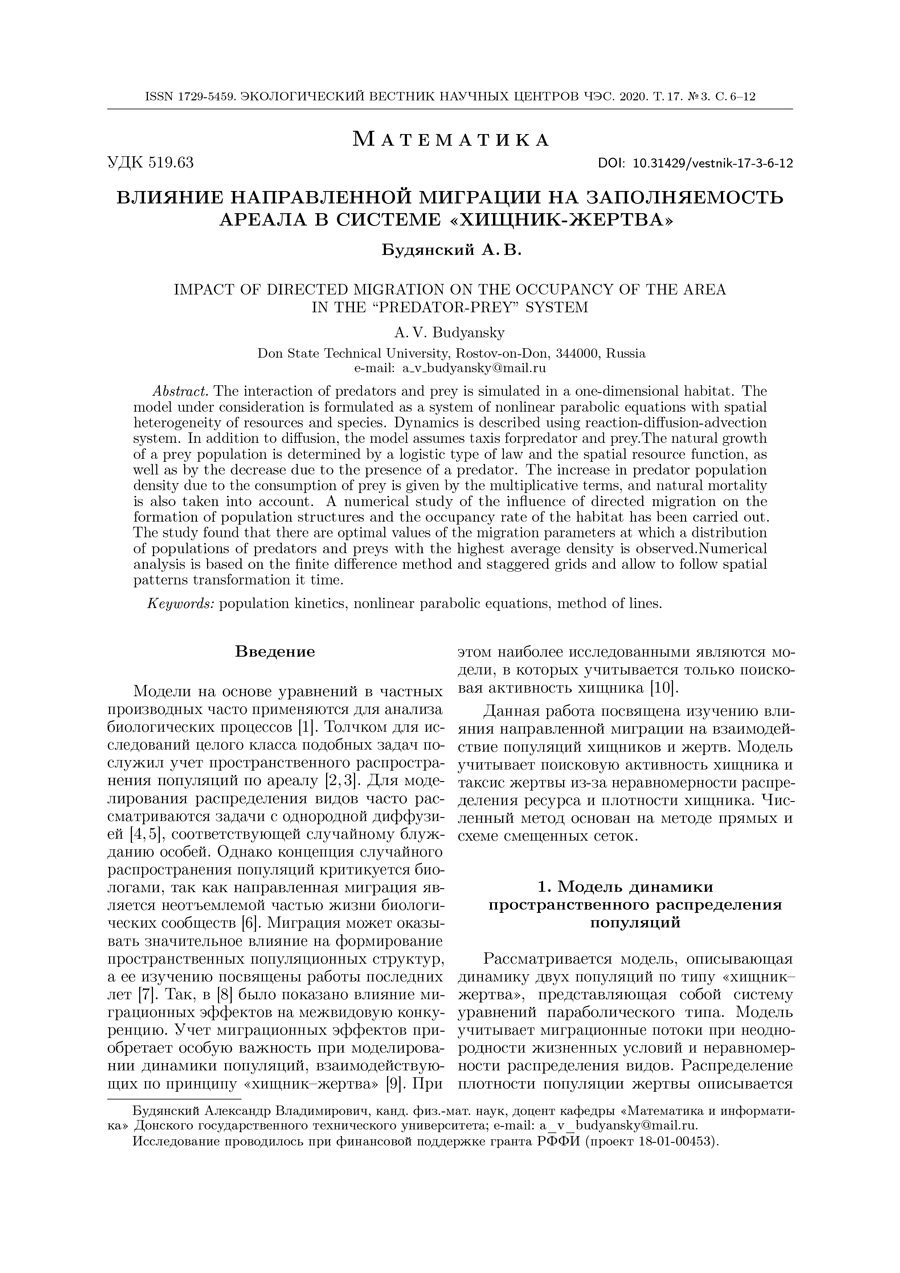Impact of Directed Migration on the Occupancy of the Area in the "Predator-Prey" System
UDC
519.63DOI:
https://doi.org/10.31429/vestnik-17-3-6-12Abstract
The interaction of predators and prey is simulated in a one-dimensional habitat. The model under consideration is formulated as a system of nonlinear parabolic equations with spatial heterogeneity of resources and species. Dynamics is described using reaction-diffusion-advection system. In addition to diffusion, the model assumes taxis forpredator and prey.The natural growth of a prey population is determined by a logistic type of law and the spatial resource function, as well as by the decrease due to the presence of a predator. The increase in predator population density due to the consumption of prey is given by the multiplicative terms, and natural mortality is also taken into account. A numerical study of the influence of directed migration on the formation of population structures and the occupancy rate of the habitat has been carried out. The study found that there are optimal values of the migration parameters at which a distribution of populations of predators and preys with the highest average density is observed.Numerical analysis is based on the finite difference method and staggered grids and allow to follow spatial patterns transformation it time.
Keywords:
population kinetics, nonlinear parabolic equations, method of linesAcknowledgement
References
- Murray, J.D. Mathematical Biology II. Spatial models and Biomedical Applications. Springer-Verlag, 2003.
- Kolmogorov, A., Petrovskii, I., Piscounov, N. A study of the diffusion equation with increase in the amount of substance, and its application to a biological problem. Bull. Moscow Univ., Math. Mech., 1937, vol. 1, pp. 1–25.
- Fisher, R.A. The wave of advance of advantageous genes. Ann. Eugenis., 1937, vol. 7, pp. 353–369.
- Dockery, J., Hutson, K., Mischaikow, M., Pernarowski, M. The evolution of slow dispersal rates: A reaction-diffusion equations. J. Math. Biol., 1998, vol. 37, pp. 61–83.
- Cosner, C., Cantrell, R. Spatial ecology via reaction-diffusion equation. John Wiley & Sons Ltd, Chichester. 2003.
- Begon, M., Harper, J.L., Townsend, C.R. Ecology: Individuals, Populations and Communities. Blackwell Scientific Publications Oxford. 1986.
- Cosner, C. Reaction-diffusion-advection models for the effects and evolution of dispersal. Discrete and continuous dynamical systems, 2014, vol. 4, iss. 5, pp. 1701–1745.
- Budyansky, A.V., Tsybulin, V.G. Impact of Directed Migration on Formation of Spatial Structures of Populations. Biophysics, 2015, vol. 60, pp. 622–631.
- Budyansky, A.V., Frischmuth, K., Tsybulin, V.G. Cosymmetry approach and mathematical modeling of species coexistence in a heterogeneous habitat. Discrete and Continuous Dynamical Systems – B, 2019, vol. 24(2), pp. 547–561. doi: 10.3934/dcdsb.2018196
- Arditi, R., Tyutyunov, Yu., Senina, I., Morgulis, A., Govorukhin, V. Directed movement of predators and the emergence of density-dependence in predator-prey models. Theoretical Population Biology, 2001, vol. 59, iss. 3, pp. 207–221.
Downloads
Submitted
Published
How to Cite
Copyright (c) 2020 Budyansky A.V.

This work is licensed under a Creative Commons Attribution 4.0 International License.




